South Fork Silver Creek ELF
Editor's Note: This trip report courtesy of Bill Tuthill, who manages the excellent website California Creeks. Text by Bill Tuthill, photos by Chris Ford.
The South Fork of Silver Creek above Icehouse reservoir, between Placerville and Lake Tahoe, is a freak of nature. In 1.5 miles it drops almost 600 feet per mile, with one section (Teacups to Offramp) 800 fpm. Yet only one portage is mandatory, and almost all other rapids are commonly run at typical flows.
Having boated it last year, Brad Klaas led me down, luckily for me. Chris Ford hiked with camera. I had no experience with high-gradient waterfall runs, and did not know what was in store for me.
The trail to put-in was longer than I expected, perhaps 1/2 mile. It is possible to put in upstream nearer the dirt road, but then you have to negotiate some distance of irrigated boulder piles, which I've heard kayakers call "gorilla" boating, I suppose because long arms are required. The first rapid starting at put-in looked heinously steep, but Brad assured me it was nothing compared to what lay downstream.
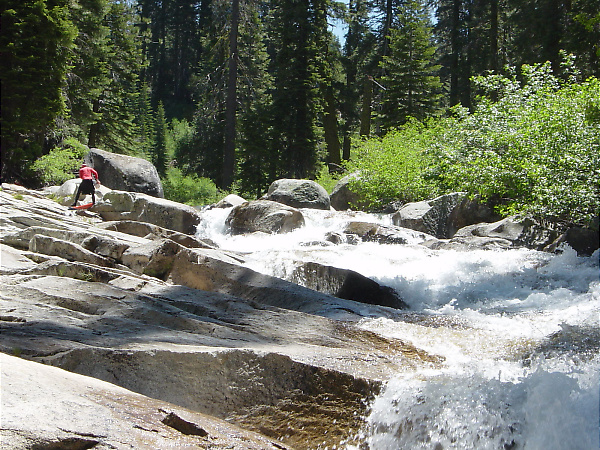
Puttin' on wetsuit and elbow pads.
Brad ran it first, getting turned backwards and complaining of shallow water (hardshell kayakers had abandoned this run two weeks before).
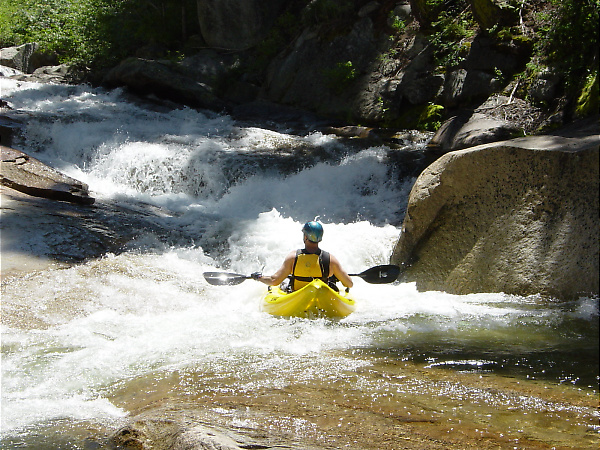
Brad boats backwards nonchalantly.
I had been scared about Autobahn, which looks fast and furious in the pictures. The rock at bottom left was out of play due to low water, but an undercut rock on the left looked hard to avoid, shown on center right of this picture.
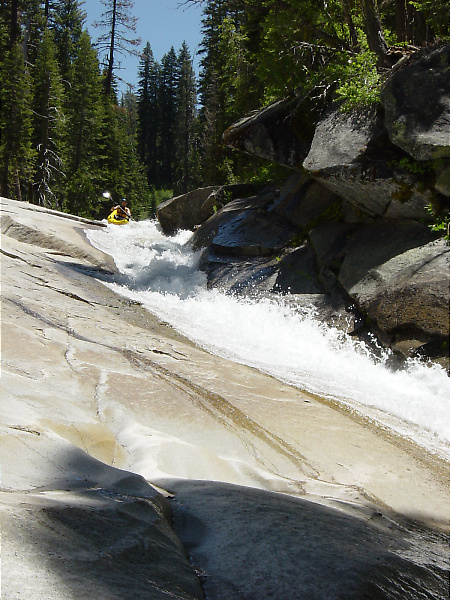
Brad at the top of Autobahn.
Brad had a good run, but was surprised to get launched in the air (for several yards!) by the submerged rock in this picture.
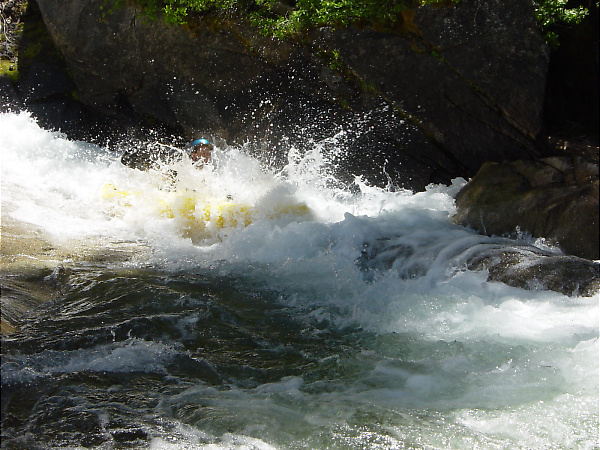
Low-water launch rock just underwater on the right.
I got pushed too far left above the undercut, but managed to straighten out in the shallow water and got launched at the bottom also.
Four Foot Boof (Single Drop) followed. My boat washed thru the mild undercut, but Brad's boat got stuck for a minute. Double Drop followed. The water was so shallow we had to portage the first drop. Just a little more water would have cured this.
Triple Slide followed almost immediately. Brad had a good run, but I got sideways in the second slide. This was when I realized it's better to straighten out using hands (not paddle) if the water is only one centimeter deep!
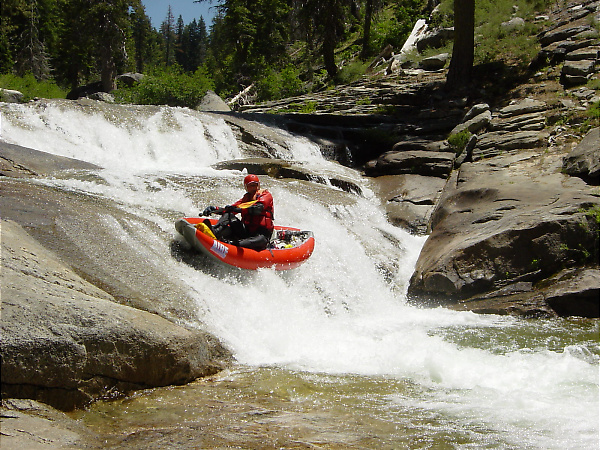
Just before my first swim of the day.
I was thankful for the elbow pads, because this is probably where I put a good-size scratch in the left one. Fortunately I climbed back in my boat before the third slide, actually a series of slides.
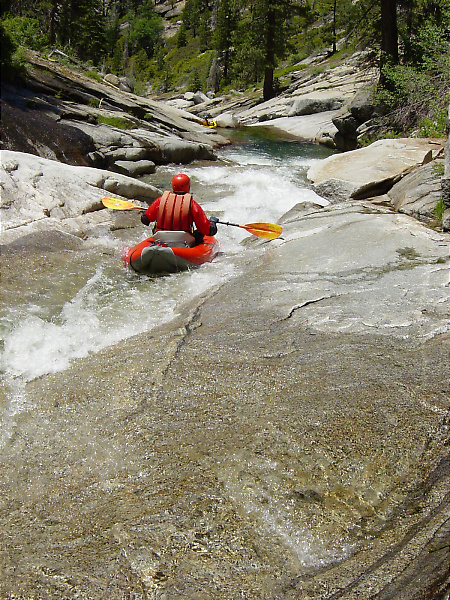
Triple Slide third half.
Although its first two drops looked runnable, Boof-Boof-Slide was a twisting one-foot-wide ribbon of foam against the bottom left wall, so we ghost boated it. The year before, Brad had made the same decision.
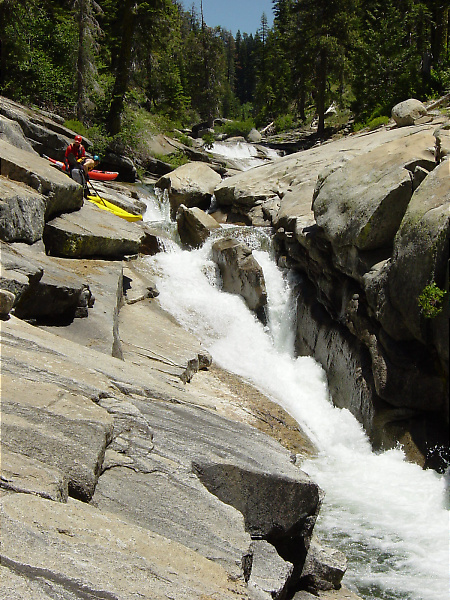
Boof-Boof-Slide needs more water to become runnable.
The Four Teacups followed; we really enjoyed them. This might be the heart of the run. They supposedly range between 8 and 16 feet in height, with two smaller falls separating the Third and Fourth Teacup. We met some inner tubers who had hiked over a mile uphill just to run the First, Third and Fourth Teacups. They wouldn't touch the second, which is known as the most difficult, though not the tallest.
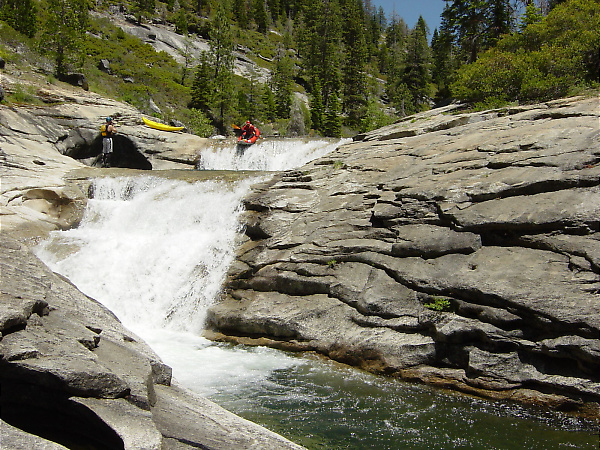
First Teacup is straightforward.
Brad probably got too far right in the Second Teacup, and had an uncharacteristic swim.
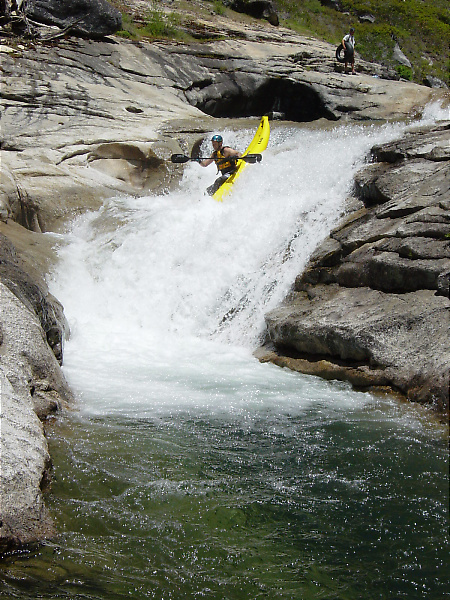
Note that Second Teacup piles straight into the right wall.
Teacups 3.3 and 3.6 followed, relatively non-tall but with bigger hydraulics than appear in pictures. The Fourth Teacup is the tallest, although fortunately (because of its placement just above Skyscraper) not the most difficult.
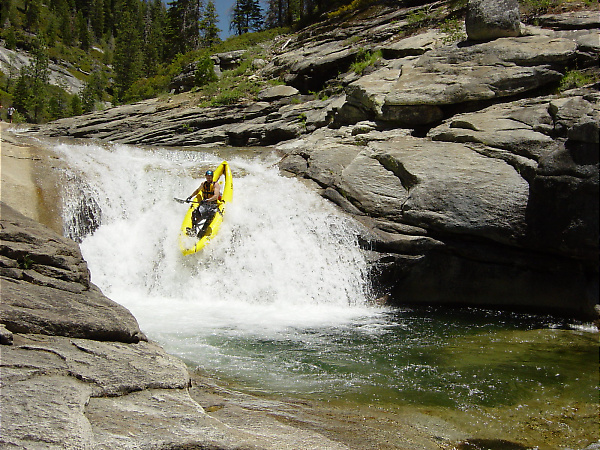
Brad takes the best "deep" water line in Fourth Teacup.
Runout from Fourth Teacup comes perilously close to Skyscraper, a falls of about 45 feet in three stages.
Skyscraper, omigawd. I was not scared of it because I did not plan to run it. But Brad bamboozled me, electing to run the last 2/3 of Skyscraper by lowering his boat down to barely-wet bedrock in midstream. Now I was scared for him.
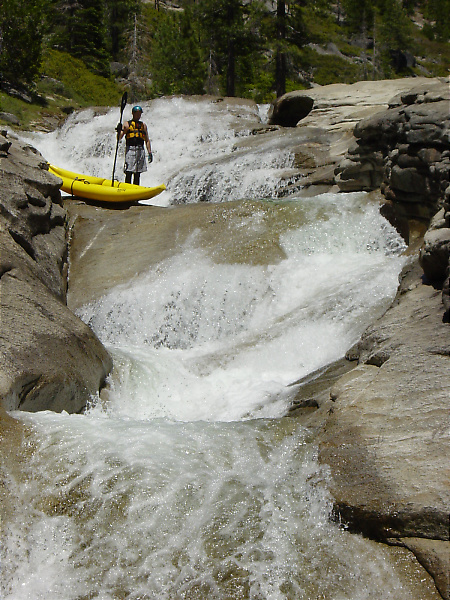
Brad ponders which route to take, falls or ramp.
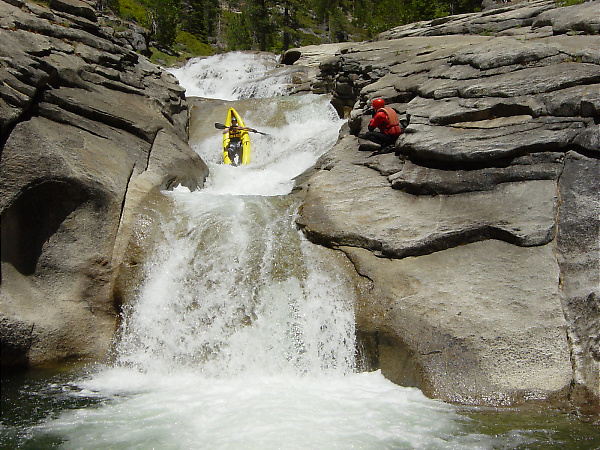
Brad elects to take the falls.
He aced it! Brad was so excited after running Skyscraper that he neglected to eddy out above Offramp.
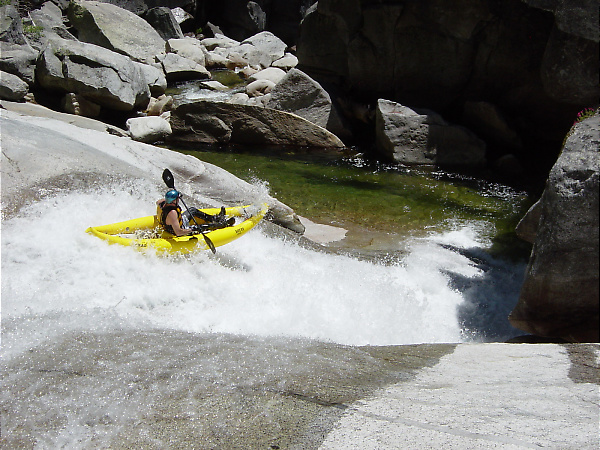
Brad from above, at the ski jump in Offramp.
Typical for me, I wimped out and ghost boated starting from the top of Skyscraper. After a perfect run, sunnyside up, my boat got stuck in an eddy along a sheer cliff on the right below the final waterfalls. Having to jump in and rescue it accounted for my second swim.
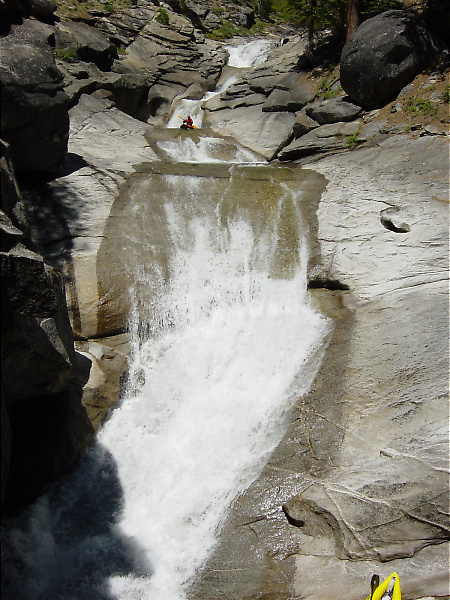
Above lead-in to Offramp after boat-rescue swim
Offramp, which old schoolers would have named Ski Jump, followed. In this one you go airborne, land like a Finnish ski jumper, then think you'll have your head pushed back into your spine by the undercut cliff below. Subsurface rocks slow you down just in time, fortunately for everyone's medical bills.
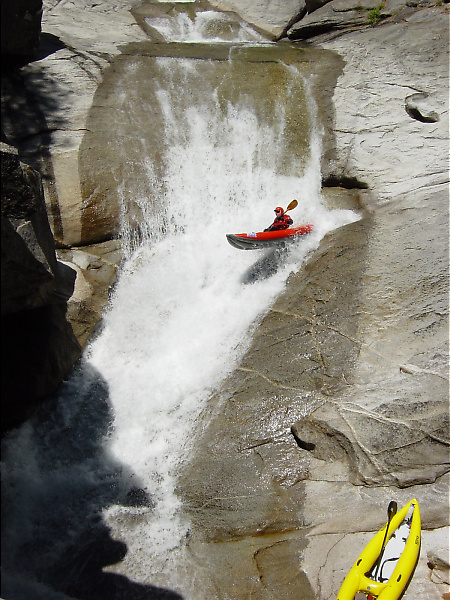
Award-winning photograph by Chris Ford.
The mandatory portage followed, hence the name Offramp. Everyone carries around this one, a steep junky rapid with several logs jammed into the rock-littered main falls.
Below there, Brad ran Nose Job, a falls of 12 feet into a narrow channel backed up by a rock, with exit left. He had swim #2, and scraped his shoulder. (Which should not count because few boaters run Nose Job, counting it as part of the portage.)
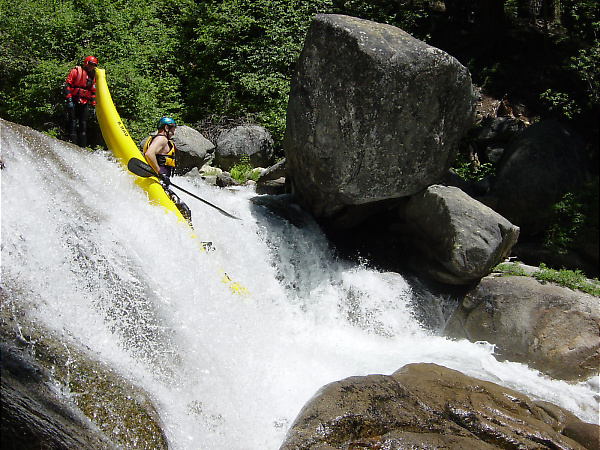
Ideal (but hopeless) entry into Nose Job.
I ghost boated this one on the left, where an undercut wall would likely have dented my helmet, but the boat was sufficiently low-profile to fit thru.
We enjoyed the series of moderate falls to a small pool above Plastic Surgery, where we eddied out to scout.
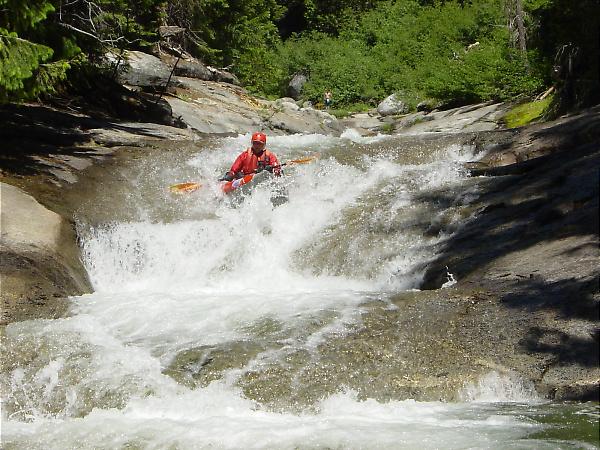
In the series of falls above Plastic Surgery.
Plastic Surgery scared me as much as Autobahn, but I had not understood perhaps the biggest problem: the force of hydraulics at the falls into its lead-in pool.
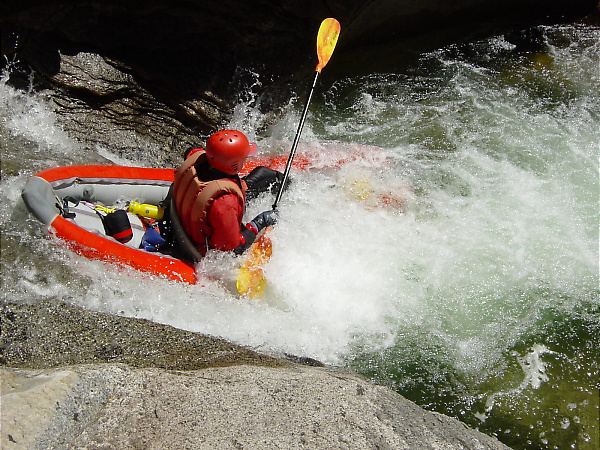
Note boat buckling even at ultralow flow.
Plastic Surgery is easier at higher flows, when a "sneak" route becomes available to the left of a midstream block-rock. But at ultralow flows this route might actually add risk.
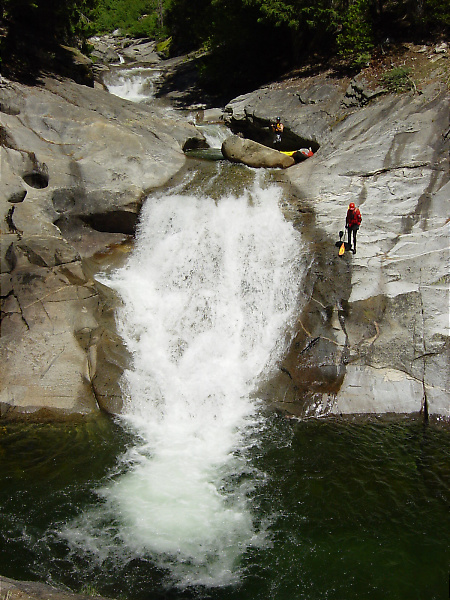
Wondering whether the sneak is actually a sneak.
Instead we executed a rock push-off on the right, and put in a few paddle strokes leftward, which combined were enough to avoid the ugly-looking pothole on the right.
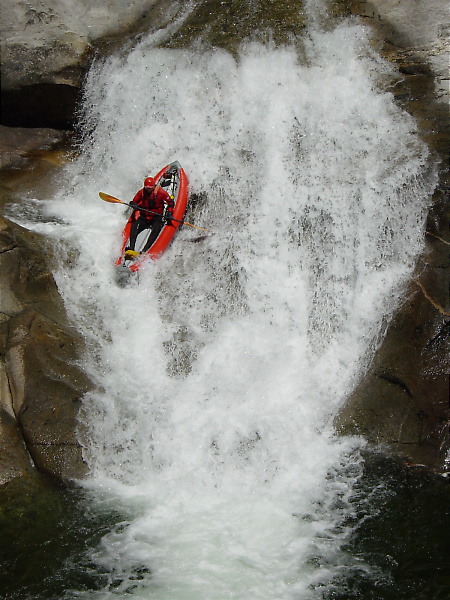
Avoiding the pothole, just by a whisker.
Next came Quadruple Bypass, a stacked-up series of four drops perhaps 5 to 8 feet high. It was a great way to end our paddling day.
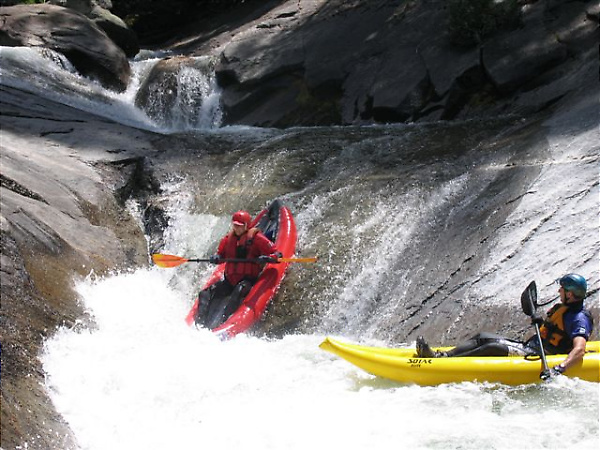
Second drop in Quadruple Bypass.
We ran one more set of drops to make carrying out easier. The carry from there is about a quarter mile slightly downhill. Two weeks earlier at higher flow, we ran that section, and really enjoyed it. But at extra low flow, it seemed easier to carry.
This section of the South Silver is an awesome mind-blowing classic. I'll be back next year. I wonder how many other stretches like this haven't been discovered yet?
_____
Thanks very much to Bill Tuthill and Brad Klaas for this excellent post. --Ed.
The South Fork of Silver Creek above Icehouse reservoir, between Placerville and Lake Tahoe, is a freak of nature. In 1.5 miles it drops almost 600 feet per mile, with one section (Teacups to Offramp) 800 fpm. Yet only one portage is mandatory, and almost all other rapids are commonly run at typical flows.
Having boated it last year, Brad Klaas led me down, luckily for me. Chris Ford hiked with camera. I had no experience with high-gradient waterfall runs, and did not know what was in store for me.
The trail to put-in was longer than I expected, perhaps 1/2 mile. It is possible to put in upstream nearer the dirt road, but then you have to negotiate some distance of irrigated boulder piles, which I've heard kayakers call "gorilla" boating, I suppose because long arms are required. The first rapid starting at put-in looked heinously steep, but Brad assured me it was nothing compared to what lay downstream.

Puttin' on wetsuit and elbow pads.
Brad ran it first, getting turned backwards and complaining of shallow water (hardshell kayakers had abandoned this run two weeks before).

Brad boats backwards nonchalantly.
I had been scared about Autobahn, which looks fast and furious in the pictures. The rock at bottom left was out of play due to low water, but an undercut rock on the left looked hard to avoid, shown on center right of this picture.

Brad at the top of Autobahn.
Brad had a good run, but was surprised to get launched in the air (for several yards!) by the submerged rock in this picture.

Low-water launch rock just underwater on the right.
I got pushed too far left above the undercut, but managed to straighten out in the shallow water and got launched at the bottom also.
Four Foot Boof (Single Drop) followed. My boat washed thru the mild undercut, but Brad's boat got stuck for a minute. Double Drop followed. The water was so shallow we had to portage the first drop. Just a little more water would have cured this.
Triple Slide followed almost immediately. Brad had a good run, but I got sideways in the second slide. This was when I realized it's better to straighten out using hands (not paddle) if the water is only one centimeter deep!

Just before my first swim of the day.
I was thankful for the elbow pads, because this is probably where I put a good-size scratch in the left one. Fortunately I climbed back in my boat before the third slide, actually a series of slides.

Triple Slide third half.
Although its first two drops looked runnable, Boof-Boof-Slide was a twisting one-foot-wide ribbon of foam against the bottom left wall, so we ghost boated it. The year before, Brad had made the same decision.

Boof-Boof-Slide needs more water to become runnable.
The Four Teacups followed; we really enjoyed them. This might be the heart of the run. They supposedly range between 8 and 16 feet in height, with two smaller falls separating the Third and Fourth Teacup. We met some inner tubers who had hiked over a mile uphill just to run the First, Third and Fourth Teacups. They wouldn't touch the second, which is known as the most difficult, though not the tallest.

First Teacup is straightforward.
Brad probably got too far right in the Second Teacup, and had an uncharacteristic swim.

Note that Second Teacup piles straight into the right wall.
Teacups 3.3 and 3.6 followed, relatively non-tall but with bigger hydraulics than appear in pictures. The Fourth Teacup is the tallest, although fortunately (because of its placement just above Skyscraper) not the most difficult.

Brad takes the best "deep" water line in Fourth Teacup.
Runout from Fourth Teacup comes perilously close to Skyscraper, a falls of about 45 feet in three stages.
Skyscraper, omigawd. I was not scared of it because I did not plan to run it. But Brad bamboozled me, electing to run the last 2/3 of Skyscraper by lowering his boat down to barely-wet bedrock in midstream. Now I was scared for him.

Brad ponders which route to take, falls or ramp.

Brad elects to take the falls.
He aced it! Brad was so excited after running Skyscraper that he neglected to eddy out above Offramp.

Brad from above, at the ski jump in Offramp.
Typical for me, I wimped out and ghost boated starting from the top of Skyscraper. After a perfect run, sunnyside up, my boat got stuck in an eddy along a sheer cliff on the right below the final waterfalls. Having to jump in and rescue it accounted for my second swim.

Above lead-in to Offramp after boat-rescue swim
Offramp, which old schoolers would have named Ski Jump, followed. In this one you go airborne, land like a Finnish ski jumper, then think you'll have your head pushed back into your spine by the undercut cliff below. Subsurface rocks slow you down just in time, fortunately for everyone's medical bills.

Award-winning photograph by Chris Ford.
The mandatory portage followed, hence the name Offramp. Everyone carries around this one, a steep junky rapid with several logs jammed into the rock-littered main falls.
Below there, Brad ran Nose Job, a falls of 12 feet into a narrow channel backed up by a rock, with exit left. He had swim #2, and scraped his shoulder. (Which should not count because few boaters run Nose Job, counting it as part of the portage.)

Ideal (but hopeless) entry into Nose Job.
I ghost boated this one on the left, where an undercut wall would likely have dented my helmet, but the boat was sufficiently low-profile to fit thru.
We enjoyed the series of moderate falls to a small pool above Plastic Surgery, where we eddied out to scout.

In the series of falls above Plastic Surgery.
Plastic Surgery scared me as much as Autobahn, but I had not understood perhaps the biggest problem: the force of hydraulics at the falls into its lead-in pool.

Note boat buckling even at ultralow flow.
Plastic Surgery is easier at higher flows, when a "sneak" route becomes available to the left of a midstream block-rock. But at ultralow flows this route might actually add risk.

Wondering whether the sneak is actually a sneak.
Instead we executed a rock push-off on the right, and put in a few paddle strokes leftward, which combined were enough to avoid the ugly-looking pothole on the right.

Avoiding the pothole, just by a whisker.
Next came Quadruple Bypass, a stacked-up series of four drops perhaps 5 to 8 feet high. It was a great way to end our paddling day.

Second drop in Quadruple Bypass.
We ran one more set of drops to make carrying out easier. The carry from there is about a quarter mile slightly downhill. Two weeks earlier at higher flow, we ran that section, and really enjoyed it. But at extra low flow, it seemed easier to carry.
This section of the South Silver is an awesome mind-blowing classic. I'll be back next year. I wonder how many other stretches like this haven't been discovered yet?
_____
Thanks very much to Bill Tuthill and Brad Klaas for this excellent post. --Ed.


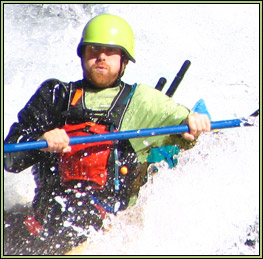
<< Home